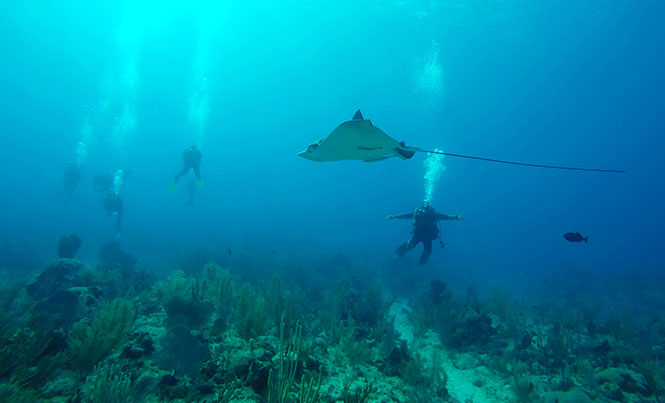
The team dove at both Cayo Largo and Maria Gorda in S.W. Cuba
An international team of experts from Mexico, Cuba and the U.S.A met this October in Cuba to work together on the spotted eagle ray conservation and research project. A large tri-national project studying the ecosystem of the Gulf of Mexico and northern Caribbean Sea which includes sharks and rays’ migrations across the area (www.trinationalinitiative.org/sharks) has been in place for about 10 years. This trip by the international team aimed to gather information about spotted eagle rays and their seasonality in Cuba and to engage the tour operators and involve them in the project.
Cayo Largo and Maria Gorda, both located in southwest Cuba, are key sites for SCUBA diving in Cuba. Both seem to also be key sites for spotted eagle ray aggregations. Tour operators and divers have known for a long time of the occurrence of these rays although have not paid much attention to their seasonality or key habitats, yet. With the help of colleagues from the Center for Marine Research (CIM, University of Havana) the team traveled to both sites, went SCUBA diving/snorkeling, and gave informal conferences to inform and engage the divers. Informative brochures were given, and logbooks were arranged so that the local divers could start recording their sightings to create the first database of spotted eagle rays in Cuba. The team did get to see two spotted eagle rays during the dives! And quite a few queen conch which is the rays’ main prey item and is an endangered species in the Mexican Caribbean due to overharvesting.
Along with these collaborations and on-the-ground work, the Mexican members of the international team (from Blue Core A.C.) presented the results of the first library of spotted eagle rays photo-ID in Mexico in an international environment conference held in Cayo Coco, Cuba during this trip in October.
The work on marine migratory fauna and shared ecosystems by the three countries still has a long way to go. We can only hope scientists and policy makers work fast and close enough to afford some protection to such beautiful environment before massive tourism development turns the area into another environmentally damaged zone.